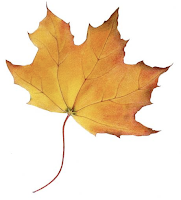 |
| white pine |
Because the area has quartzite bedrock, the soil is more acidic and lower in nutrients than usually in Wisconsin, and his in combination with variable topography (northern and southern slopes, cold air drainage) creates an environment that northern species prefer, so we see a mixture of southern and northern species in the area. Since the area is heavily wooded, we see
white pine (
Pinus strobus), which i the most shade-tolerant pine in Wisconsin, instead of jack or red pine (jack pine is the least shade-tolerant of all).
 |
| red maple |
 |
| sugar maple |
We found
sugar maple (
Acer saccharum s.s.) as well as
red maple (
Acer rubrum), the two of which can be told apart by the slight differences on their leaves. If you take a close look, you'll notice the U-shaped curve between leaf margins on the sugar maple leaf, while the red maple leaf has more of a sharp V.
Another set of easy-to-confuse plants are
grape woodbine or Virginia creeper (
Parthenocissus vitacea) and poison ivy, our nasty but faithful friend who pops up pretty much everywhere. Woodbine is one of the most ecologically widespread species (which is not the same as the most common), and often grows together with poison ivy. For a long time botanists thought there were just one of each, but later they found out that there are two species of woodbine and two species of poison ivy as well. Well, whichever species you come across, poison ivy always has three leaves, whereas woodbine usually has five, so you can tell them apart.
 |
| woodbine (left) and poison ivy (right) |
 |
| doll's eyes |
Doll's eyes (
Actaea pachypoda) or white baneberry is a herbaceous perennial plant.
Its most striking feature is its fruit, a 1 cm diameter white berry, whose size, shape, and black stigma scar give the species its other common name, "doll's eyes".The berries are highly poisonous, and the entire plant is considered poisonous to humans. The berries contain cardiogenic toxins which can have an immediate sedative effect on human cardiac muscle tissue, and are the most poisonous part of the plant. Ingestion of the berries can lead to cardiac arrest and death. The berries are harmless to birds, the plant's primary seed dispersers. Both Native American and settlers made tea out of the roots for relieving pain of childbirth. Settlers also used the plant to improve circulation and to cure headache or eyestrain.
 |
| yellow birch |
Yellow birch (
Betula alleghaniensis) needs coars woody debris to grow
. The bark is smooth, yellow-bronze, flaking in fine horizontal strips, and often with small black marks and scars. The twigs, when scraped, have a slight scent of oil of wintergreen.
 |
| ring of baby shoots around parent basswood |
Basswood or linden (Tilia spp.) is not shade-tolerant, so it competes with much better shade-tolerant sugar maple by forming a "fairy ring" or baby shoots around the parent tree, so when the parent dies, the shoots are ready to take its place, and sugar maple does not have any time to catch up.
 |
| jewelweed |
 |
| lumberjack's toiletpaper |
 |
| maidenhair fern |
A couple of other fun plants we saw:
large-leaved aster (
Aster macrophyllus) or lumberjack's toiletpaper,
maidenhair fern (
Adiantum spp.),
bellflower (
Campanula spp.)
witch hazel (
Hamamelis spp.), which blooms in the fall, unlike most shrubs, and
jewelweed (Impatiens spp.) of touch-me-not, which (based on anecdotal evidence) can be used as a remedy for poison ivy rashes. If crushed and rubbed into the skin soon after the encounter with poison ivy, it is rumored to make things better. Since the two plants often grow together, it's a fairly convenient solution - much like having a candy store and a dentist next to other :).
 |
| witch hazel |
 |
| bellflower |
 |
| Otter Creek |
The creek we explored, Otter Creek, provides home for at least 72 species of caddis flies, plus a couple more that were discovered later. Many
ephemeral insects emerge for only 1 day, mate, lay eggs and then die. An interesting little fact for trout fishers is that trouts know their flies very well, so you need to match the flies availabe at the time to the bait you use, otherwise the trout are just going to laugh at you.
 |
| clubmoss |
 |
| partridge berry |
 |
| skunk cabbage |
Finally, a few plants I found by the creek, which might or might not have caught your eye: clubmoss (Lycopodium spp.), partridge berry (Mitchella repens) and skunk cabbage (Symplocarpus foetidus).






No comments:
Post a Comment